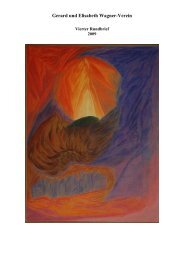Zweiter Rundbrief - Gerard Wagner - gerardwagner.de
Zweiter Rundbrief - Gerard Wagner - gerardwagner.de
Zweiter Rundbrief - Gerard Wagner - gerardwagner.de
Sie wollen auch ein ePaper? Erhöhen Sie die Reichweite Ihrer Titel.
YUMPU macht aus Druck-PDFs automatisch weboptimierte ePaper, die Google liebt.
has led to me being greatly preoccupied with learning all I can about pigments and dyes, bin<strong>de</strong>rs<br />
and mediums, painting surfaces, and so on. And this has given me the distinct feeling of finally<br />
having a firm ground on which to stand before going any further with the <strong>de</strong>eper questions.<br />
Exploring those <strong>de</strong>eper questions did lead me to the conviction that trying to un<strong>de</strong>rstand plant<br />
colours, and especially trying to un<strong>de</strong>rstand them in any kind of new way, can enrich us in our<br />
quest to un<strong>de</strong>rstand how spirit and substance relate to one another, and how we relate to spirit in<br />
substance (do we firstly even acknowledge with conviction that spirit is in substance?). I will<br />
quote Rudolf Steiner here, from the third of the principle three lectures he gave to painters: “And<br />
when we practise the art of painting, which is the art of colour, we must of course use materials<br />
for our paints and be aware of their properties, how to mix them and so on. Here we come upon a<br />
significant question, which is really left unanswered by the customary knowledge of the time,<br />
namely: how is colour – which we have learnt to know as constantly in movement, whether image<br />
or lustre – related to matter and material objects? What makes matter appear coloured?<br />
“Anyone who has looked into Goethe’s ‘Theory of Colour’ will probably know that, out of a certain<br />
intellectual honesty, he never really <strong>de</strong>alt with this question, because he realised that with the<br />
means at his disposal he could not get to the heart of the problem: how is colour attached to solid<br />
matter? Yet this question is highly relevant to art, and painting. For painting is, to all appearance,<br />
concerned with just this phenomenon. We apply the colour and try to evoke an impression with it.<br />
So it is at this point, when we want to apply our investigations into the nature of colour to the art<br />
of painting, that we become interested in the appearance of colour in matter.”<br />
Not only from such quotes from Rudolf Steiner, but from many a thing, have I come to the conviction<br />
myself that colour can only be un<strong>de</strong>rstood in its most intimate nature by painters. Colour is<br />
the vocation of painters. In many different places, Steiner explained colour in its many manifestations,<br />
for instance in the agriculture course where he explains the colours of plant blossoms from<br />
one point of view. I have found, after many a dark night of the soul struggling with these questions<br />
of colour, that none of Steiner’s comments on colour of the type just mentioned mean anything<br />
to me unless I am a painter, unless I put my painterly feeling first. I think even the spiritual<br />
scientific knowledge that a blue blossom is blue due to the influence of Saturn, via silica and clay<br />
in the soil and the plant’s root, is worthless if I do not also cultivate a strong feeling for the colour<br />
blue (but I would call it ‘knowing-feeling’). I would say that, after what nature herself does with it,<br />
there is no worthier use colour can be put to than in the art of painting.<br />
In human history, the sources of colours for pigment and dyeing have stood alongsi<strong>de</strong> fabrics and<br />
metals and the like in terms of their importance to civilization, and hence their value and the status<br />
accor<strong>de</strong>d to those in control of the source of a colour; it used to be that those with this control<br />
were, as a result, wealthy, and wiel<strong>de</strong>d a great <strong>de</strong>al of power in the world of tra<strong>de</strong>. The acci<strong>de</strong>ntal<br />
discovery of synthetic colours from coal tar by 18-year-old Englishman William Perkin in 1856<br />
drastically changed things, and not least the art of painting, leading as it did to the availability of<br />
cheap paints, and, from one point of view, to the possibility of a more frivolous attitu<strong>de</strong> towards<br />
the art of painting (and to colour itself!) – sud<strong>de</strong>nly almost anyone could buy some colours and do<br />
some painting, and put those paintings out in the world. Synthetic colours ‘changed the rules’.<br />
I would hypothesize that many of the <strong>de</strong>velopments in painting history over the last 150 years<br />
(movements, styles) can be seen to be, in large part, the result of the discovery of synthetic colour,<br />
as harsh or ludicrous as that may sound to some. (Also the discovery and <strong>de</strong>velopment of synthetic<br />
colours roughly coinci<strong>de</strong>d with the discovery and <strong>de</strong>velopment of photography, which, it is<br />
well-known, also caused serious damage to the dignity of painting; and anyway created a strong<br />
change in attitu<strong>de</strong> towards it).<br />
Synthetic colours, then, as it turns out, are actually, indirectly, ma<strong>de</strong> from plants; but fossilized<br />
plants in the form of coal. Rudolf Hauschka drew attention to the <strong>de</strong>velopment of other substanc-<br />
19









